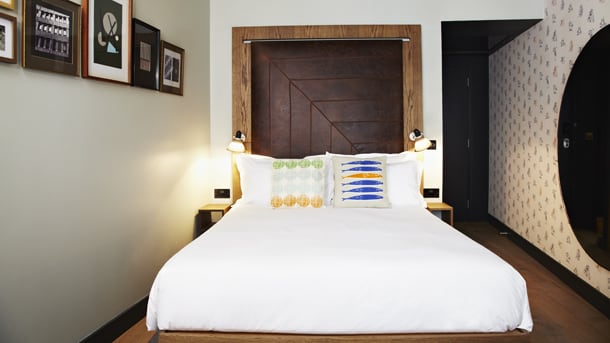That’s according to a panel of design experts at The Annual Hotels Conference (AHC), held at Manchester’s Hilton Deansgate Hotel just last week.
Speaking on the panel were Sara Cosgrove of the design agency of the same name; Jason Holley of the Universal Design Studio (the team behind the Ace Hotel); Susanna Kingston of Ennismore, whose sites include The Hoxton in London, and Gleneagles in Auchterader; and Jonathan Manser of the Manser Practise.
The debate was chaired by Catherine Martin, editor of Sleeper magazine.

Discussing the question of value in design and how hotels can create spaces that people want to spend time in, the panel agreed that flexible lobby space is now paramount in hotels that are hoping to attract guests and locals, with multifunctional space the most important aspect to consider.
Flexibility was key, with spaces now designed with guests’ needs most in mind, both corporate and leisure.
Major elements to consider included plugs at every table or at every bedside cabinet, USB charging ports, good lighting, and functional furniture – such as chairs that are actually suited to the kinds of groups that will be using them at the given time of day, whether relaxing, in professional meetings, or working.
Also highlighted were acoustics – including investment in acoustic ceilings to dampen noise levels – and lighting that can be centrally changed throughout the day to allow a day-to-night atmosphere.
Transferable touches
Hotels such at The Hoxton and Ace were shown as leading examples of those getting it right, but luxury resort Gleneagles (owned by Ennismore after it bought the business in 2015) was also shown as proof that even design elements seen in relaxed, informal and urban venues can be transferred to more formal and traditional environments.
Similarly, Ennismore’s new concept, NoCo, is seeking to incorporate elements of a higher-end, design-led hotel such at The Hoxton, into a more value, budget-style brand, showing that design-led, flexible spaces need not apply to only a small section of the market.
At Gleneagles, small details included taking staff out from behind a desk and giving them a lighter-feeling podium, or even iPads, to allow them to move more flexibly and approach guests more easily. Whether high-end or budget, lighting and acoustics could also be considered, without compromising the core values of the businesses.

The incredible shrinking bedroom
The designers also explained that as the hotel focus in moves towards communal spaces, bedroom sizes are shrinking – especially in urban hotels ‒ with details such as technology, charging points, free and fast Wi-Fi seen as more important than extra space or even windows.
All hotels should now have free, fast Wi-Fi as standard, the panel agreed, as well as plugs everywhere and USB charging points too.
Jonathan Manser said: “As public spaces become more multifunctional, there is a tendency to reduce bedroom sizes, to allow public rooms to generate more revenue. Bedrooms are now more likely to be small cabins, but they are beautifully designed and still have crucial things such as good showers and comfortable beds.”
Human connection
Similarly, creating a good atmosphere and getting people to use public spaces more was seen as a positive influence on the hotel business overall, even if some may only come for the free Wi-Fi and order just one coffee.
Holley said: “Lots of clients now want something more human and connected. In the lobby, for example, that is all about people trying to tailor the spaces to suit people’s need. We found that many spaces were really redundant and not delivering anything useful. We’ve always approached projects from the point of view of the guests’ needs. It’s sometimes quiet design that doesn’t shout much, but works well. Great acoustics and fantastic lighting that improves your way of life in a simple way.”
Cosgrove said: “A one-size-fits all doesn’t work anymore, and we haven’t been able to shoehorn the same design into each property. At The Palace, for example it’s about creating spaces that are incredibly social, that appeal to different demographics, and that also have space for great events and exhibitions.
“Overall, it’s the ‘local living room idea’, which really originated at The Ace. People now need more flexibility when it comes to work, and it’s really about creating design that adds value to the building and to the community.”
As Manser concluded: “It’s about getting people into the hotel, and making sure they stay there.”
